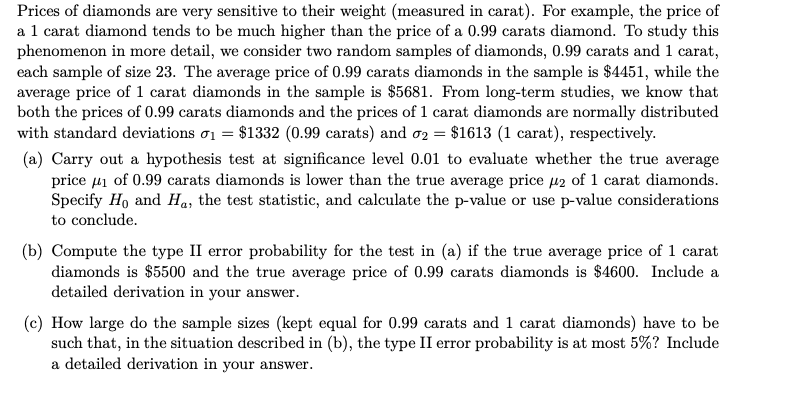Prices of diamonds are very sensitive to their weight (measured in carat). For example, the price of a 1 carat diamond tends to be much higher than the price of a 0.99 carats diamond. To study this phenomenon in more detail, we consider two random samples of diamonds, 0.99 carats and 1 carat, each sample of size 23. The average price of 0.99 carats diamonds in the sample is $4451, while the average price of 1 carat diamonds in the sample is $5681. From long-term studies, we know that both the prices of 0.99 carats diamonds and the prices of 1 carat diamonds are normally distributed with standard deviations o1 = $1332 (0.99 carats) and o2 = $1613 (1 carat), respectively. (a) Carry out a hypothesis test at significance level 0.01 to evaluate whether the true average price µi of 0.99 carats diamonds is lower than the true average price µ2 of 1 carat diamonds. Specify Ho and Ha, the test statistic, and calculate the p-value or use p-value considerations to conclude. (b) Compute the type II error probability for the test in (a) if the true average price of 1 carat diamonds is $5500 and the true average price of 0.99 carats diamonds is $4600. Include a detailed derivation in your answer.
Prices of diamonds are very sensitive to their weight (measured in carat). For example, the price of a 1 carat diamond tends to be much higher than the price of a 0.99 carats diamond. To study this phenomenon in more detail, we consider two random samples of diamonds, 0.99 carats and 1 carat, each sample of size 23. The average price of 0.99 carats diamonds in the sample is $4451, while the average price of 1 carat diamonds in the sample is $5681. From long-term studies, we know that both the prices of 0.99 carats diamonds and the prices of 1 carat diamonds are normally distributed with standard deviations o1 = $1332 (0.99 carats) and o2 = $1613 (1 carat), respectively. (a) Carry out a hypothesis test at significance level 0.01 to evaluate whether the true average price µi of 0.99 carats diamonds is lower than the true average price µ2 of 1 carat diamonds. Specify Ho and Ha, the test statistic, and calculate the p-value or use p-value considerations to conclude. (b) Compute the type II error probability for the test in (a) if the true average price of 1 carat diamonds is $5500 and the true average price of 0.99 carats diamonds is $4600. Include a detailed derivation in your answer.
Linear Algebra: A Modern Introduction
4th Edition
ISBN:9781285463247
Author:David Poole
Publisher:David Poole
Chapter7: Distance And Approximation
Section7.3: Least Squares Approximation
Problem 31EQ
Related questions
Concept explainers
Contingency Table
A contingency table can be defined as the visual representation of the relationship between two or more categorical variables that can be evaluated and registered. It is a categorical version of the scatterplot, which is used to investigate the linear relationship between two variables. A contingency table is indeed a type of frequency distribution table that displays two variables at the same time.
Binomial Distribution
Binomial is an algebraic expression of the sum or the difference of two terms. Before knowing about binomial distribution, we must know about the binomial theorem.
Topic Video
Question
Need an answer for b) only!

Transcribed Image Text:Prices of diamonds are very sensitive to their weight (measured in carat). For example, the price of
a 1 carat diamond tends to be much higher than the price of a 0.99 carats diamond. To study this
phenomenon in more detail, we consider two random samples of diamonds, 0.99 carats and 1 carat,
each sample of size 23. The average price of 0.99 carats diamonds in the sample is $4451, while the
average price of 1 carat diamonds in the sample is $5681. From long-term studies, we know that
both the prices of 0.99 carats diamonds and the prices of 1 carat diamonds are normally distributed
with standard deviations ơ1 = $1332 (0.99 carats) and o2 = $1613 (1 carat), respectively.
(a) Carry out a hypothesis test at significance level 0.01 to evaluate whether the true average
price µi of 0.99 carats diamonds is lower than the true average price µ2 of 1 carat diamonds.
Specify Ho and Ha, the test statistic, and calculate the p-value or use p-value considerations
to conclude.
(b) Compute the type II error probability for the test in (a) if the true average price of 1 carat
diamonds is $5500 and the true average price of 0.99 carats diamonds is $4600. Include a
detailed derivation in your answer.
(c) How large do the sample sizes (kept equal for 0.99 carats and 1 carat diamonds) have to be
such that, in the situation described in (b), the type II error probability is at most 5%? Include
a detailed derivation in your answer.
Expert Solution
This question has been solved!
Explore an expertly crafted, step-by-step solution for a thorough understanding of key concepts.
This is a popular solution!
Trending now
This is a popular solution!
Step by step
Solved in 2 steps

Knowledge Booster
Learn more about
Need a deep-dive on the concept behind this application? Look no further. Learn more about this topic, statistics and related others by exploring similar questions and additional content below.Recommended textbooks for you

Linear Algebra: A Modern Introduction
Algebra
ISBN:
9781285463247
Author:
David Poole
Publisher:
Cengage Learning

Glencoe Algebra 1, Student Edition, 9780079039897…
Algebra
ISBN:
9780079039897
Author:
Carter
Publisher:
McGraw Hill

Holt Mcdougal Larson Pre-algebra: Student Edition…
Algebra
ISBN:
9780547587776
Author:
HOLT MCDOUGAL
Publisher:
HOLT MCDOUGAL

Linear Algebra: A Modern Introduction
Algebra
ISBN:
9781285463247
Author:
David Poole
Publisher:
Cengage Learning

Glencoe Algebra 1, Student Edition, 9780079039897…
Algebra
ISBN:
9780079039897
Author:
Carter
Publisher:
McGraw Hill

Holt Mcdougal Larson Pre-algebra: Student Edition…
Algebra
ISBN:
9780547587776
Author:
HOLT MCDOUGAL
Publisher:
HOLT MCDOUGAL